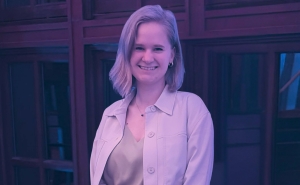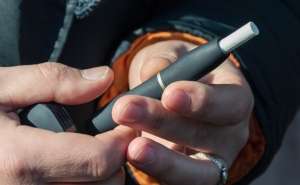Student Spotlight: Jady Li
Jady Li is a second-year ScM student in the Department of Biostatistics, with a focus on digital phenotyping.

Jady Li is a second-year ScM student in the Department of Biostatistics focusing on digital phenotyping. Li earned her Bachelor of Arts in psychology and Bachelor of Science in statistics from Wake Forest University.
"My interdisciplinary background in psychology and statistics allows me to approach health care–related questions with both rationality and humanity—balancing quantitative rigor with a deep appreciation for individual experiences and behavioral context," Li says. "I believe this perspective is essential for conducting meaningful, responsible, and empathetic health research."
How did you get interested in biostatistics?
My passion for psychology—particularly in understanding mental well-being through individual differences, social dynamics, and psychopathology—initially shaped my academic interests. This foundation in psychology sparked a deeper curiosity about how data can inform health-related outcomes. During my senior year undergrad, I completed an honors thesis in statistics, studying essential tremor patients who developed imbalances after surgery. This experience demonstrated how statistical methods can directly impact clinical decision-making and patient care. It broadened my perspective from mental to overall health and revealed the power of data in advancing well-being, ultimately motivating me to pursue biostatistics as a way to contribute to evidence-based health care.

Tell us about an experience in the Biostatistics Department that stands out as a favorite or most memorable?
One of my most memorable experiences in the Biostatistics Department was the New Year’s celebration at Mustang Alley’s, where faculty, staff, and students came together for an evening of bowling. This event provided a valuable opportunity to connect with peers and professors outside of the academic setting. Sharing laughs, cheering each other on, and enjoying casual conversations helped foster a sense of community and belonging. It was a refreshing reminder that beyond research and coursework, the department is a supportive and tight-knit group—more like a family than just colleagues or classmates.
Tell us about a project you are currently working on that you are excited about.
I’m currently working on a project under the supervision of Ciprian Crainiceanu, PhD, MS, in collaboration with William Checkley, MD, PhD, ScM, and Laura Nicolaou, PhD, from the Johns Hopkins School of Medicine, and with mentorship from Biostatistics PhD student Yu Lu. The project involves oscillometer data, which is used to assess lung function. In the short term, I’ve been focusing on visualizing the data to identify outliers and explore underlying patterns. The long-term goal is to develop meaningful indicators or summary statistics from the oscillometer signals to help quantify lung function. Ultimately, this project aims to support data-driven clinical decision-making in respiratory care.
What has been your favorite class so far?
Statistical Programming Paradigms and Workflows, taught by Stephanie Hicks, PhD, MA. It equipped me with a wide range of practical coding skills, including building interactive R Shiny applications, using GitHub for version control and collaboration, and working with command-line tools and SQL. These skills have been incredibly valuable—not only for conducting research efficiently but also for preparing to work in an industry setting where reproducibility, collaboration, and workflow management are essential.
Have you had any internships or jobs that have been helpful in your biostatistics learning journey?
I worked as a Master Statistician Intern in the Data and Analysis Standards Team at Eli Lilly in Indianapolis, where I contributed to enhancing statistical workflows for clinical trial data. My project focuses on streamlining statistical analysis and result generation for mixed models and repeated measures by developing and validating reusable R functions. These tools were designed to accommodate diverse modeling conditions and trial settings within a unified framework, supporting more consistent and efficient statistical reporting.
This experience was instrumental in my journey in biostatistics. Professionally, it gave me hands-on exposure to real-world clinical data, statistical programming in R, and model implementation in a regulated research environment. Personally, it strengthened my problem-solving skills, deepened my appreciation for collaborative teamwork, and reinforced my passion for applying statistics to meaningful health care challenges.
What advice do you have for prospective students interested in the Department of Biostatistics?
It’s completely normal to feel uncertain about your long-term path—at this stage, we’re still exploring who we are and what we want to do. The important thing is to remain open-minded and recognize the potential and possibilities ahead. Don’t hesitate to connect with people across different areas—whether in academia or industry, within or outside the department, regardless of their age or background. Every conversation is an opportunity to gain insight, broaden your perspective, and shape your journey. Also, take the time to build a strong foundation by mastering the core biostatistics courses—they’re essential for both advanced coursework and future applications in research or practice.
What do you hope to do or accomplish after graduation?
After graduation, I hope to begin my career in the health care industry, where I can apply my biostatistics training to real-world challenges in clinical research, public health, or health data science. In the short term, I’m excited to contribute to projects that improve patient outcomes and support evidence-based decision-making. While I’m still exploring long-term goals, I’m open to opportunities in both industry and academia that allow me to continue growing as a statistician and making a meaningful impact on health and well-being.




